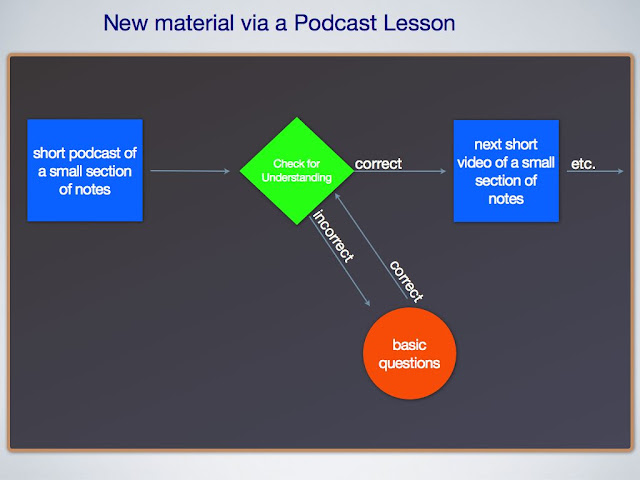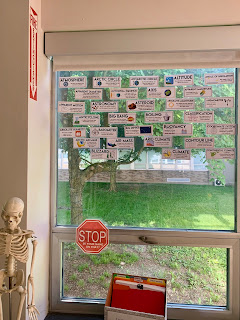2b: Establishing a Culture for Learning and 3a: Communicating with Students with Online Teaching
Or should I title this: "What could be learned from Online Teaching"?
I'd like to give you a glimpse into my online classroom
and real life classroom.
I started teaching 16 years ago and taught in a very traditional way for most of that time. I did incorporate cooperative learning and group projects here or there but for the most part I did a traditional lecture from the overhead projector because that was the most efficient way to cover/teach the material. In 2007 I made the transition from the overhead projector to a SmartBoard (interactive white board). This allowed me to use some interactive games with my students but only one student at a time could come up to the board and play the game. Often the students did not want to get up in front of their peers and look foolish as they were playing the game so that was only slightly useful. In January 2010 I attended a three day Moodle workshop at our local Erie 1 BOCES (Boards of Cooperative Educational Services). I was slightly interested in this new online tool called a Moodle. I actually thought it would be useful only because I wanted to have a website where I could put all of my teaching resources that would be locked down so from outsiders. I wanted to have a place where my stuff would only be available if I wanted to share with someone. Unknowingly, attending that workshop changed my teaching career and my student's scores on the Regents Exam. In the past my students always did very well on the Exam (I had only 1 student fail the exam in 5 years).
In future blog posts I will address all of the different online tools that I use in my classroom but in this post I want to talk about Notes; or, what we call in the online class; Extreme Notes.
The online learning platform that I use is called Moodle
What I love most about the Moodle online teaching platform is the "Lessons" activity. What this tool allows me to do is as follows:
This is how the Extreme Notes works: the students watch a short video and copy the notes (they can pause and review if they need to). They copy down the notes into their binders.
They then may watch a YouTube video that I have selected to reinforce the concept. Then they are asked a Regents level question. If they answer it correctly, they move on. If they answer it wrong, they are given a lower level question about the same concept...usually to evaluate whether or not they know the vocabulary. If they get that wrong, they go back to the video. If they get that right, they go back to the Regents question to give it another shot.
The entire process of creating what was a 40 minute lesson takes over 4 times as long to create but there are many benefits that make it worth the effort if you can find the time. When I recorded my videos I taught all four sections of my class the lesson face-to-face then during my prep period at the end of the day I would turn off my lights, lock the door and hide in the corner and record the lessons so I wouldn't be interrupted. Once interrupted, you have to start over. After the videos are created the work is not over, each lesson has to be planned out so the videos, Regents Questions, basic questions, and the sequencing has to be mapped out and put into place. I was on the computer so much at home that my husband coined a new term for me: "A mouse-potato" (similar to a couch potato...but I was always on the computer).
Here are the main benefits I have found for teaching the content online:
Benefit #1: I no longer have to teach that concept four times in the same day. Although we often make changes to adapt to each classes interests and class discussions, you have to admit that your lessons are still 95% the same in every class. Every time I was lecturing the old way I was thinking to myself that there has to be a better way to do this.
Benefit #2: Because I am not directly lecturing each class for at least 4 times a day...I don't lose my voice in November anymore. In the past I could almost predict down to the day of the year when I would have laryngitis but not anymore.
Benefit #3: I am not distracted by signing a pass, a student who is trying to do their math homework, a student with uncontrollable hiccups, a fire drill, a student trying to get the class off task, etc. I remember exactly what I want to say and exactly when I want to say it and every class gets exactly the same instruction.
Benefit #4: I now am able to assist all of my students when they are confused with something in a way that I couldn't when I was the soul source of information in the classroom. I am now my own classroom aide.
Benefit #5: My students can go through the notes at their own pace. In the past it was a struggle to keep the fast writers engaged while waiting for the slow writers to catch up. Now they can pause the video, copy what they need and listen to the video. Some students also have a problem listening to the explanations while writing. Now they can write then listen, write then listen, etc.
Benefit #6: The students can watch the videos as many times as they want without "looking stupid." They can even download them on to their iPods or iPhones and watch them anywhere to study. I had a girl in my class last year who would watch the videos on her phone while doing her hair in the morning.
Benefit #7: They can access the lessons from anywhere in the world if they have an internet connection. So now if they are on home instruction or on a family vacation, they are still a part of our class and do not miss anything going on in class.
Benefit #8: In the past, I would ask a question to the entire class and it was challenging to get all students to think about the question and come up with an answer. Although there are some ways to get more engagement from the students most often one student would answer the question and we would move on. It was tough to get all of the class to participate in their learning by thinking. By 9th grade they had become skilled in question avoidance (by not looking the teacher in the eye, letting the one student answer, and letting the class move on without them). Now, each student has to answer the questions by themselves. They can use their notes, and take the amount of time that they personally need to process the information.
At any one time in my classroom there are 24 different students at 24 different places in the unit. They may be on the same assignment as somebody near them but they are at a different part of that assignment. No longer do they have somebody right next to them with the answers. They all have to do the work themselves.
This in itself have been a huge game-changer for some students. At the beginning of the year some students will resist this new method of instruction. Not because it's new, not because it's harder, but really because they have to be engaged all of the time. It is most beneficial to students who have learning problems, processing issues, and low reading scores because they now can take the time they need to be fully engaged and to learn the material at their own pace. They also can now ask the teacher questions without the entire class noticing that they may not know something and they are more apt to do so.
originally posted at ballinwithballing.blogspot.com
I'd like to give you a glimpse into my online classroom
and real life classroom.
In future blog posts I will address all of the different online tools that I use in my classroom but in this post I want to talk about Notes; or, what we call in the online class; Extreme Notes.
The online learning platform that I use is called Moodle
(Angel and BlackBoard are some other examples of online learning platforms).
I create videos of me teaching the notes. I purposely make them no more than 3-5 minutes long. (I use
Jing Project
a Bamboo Tablet
and Keynote
on my MacBook to create the videos but you could use
a SmartBoard or other Interactive White Board
or a video camera and PowerPoint also.)
I also scour the previous Regents exams (online at: http://www.nysedregents.org/livingenvironment/ ) for questions that relate to content and I find YouTube videos that reinforce the concepts I want the students to understand. I then put them into the lesson.This is how the Extreme Notes works: the students watch a short video and copy the notes (they can pause and review if they need to). They copy down the notes into their binders.
They then may watch a YouTube video that I have selected to reinforce the concept. Then they are asked a Regents level question. If they answer it correctly, they move on. If they answer it wrong, they are given a lower level question about the same concept...usually to evaluate whether or not they know the vocabulary. If they get that wrong, they go back to the video. If they get that right, they go back to the Regents question to give it another shot.
The entire process of creating what was a 40 minute lesson takes over 4 times as long to create but there are many benefits that make it worth the effort if you can find the time. When I recorded my videos I taught all four sections of my class the lesson face-to-face then during my prep period at the end of the day I would turn off my lights, lock the door and hide in the corner and record the lessons so I wouldn't be interrupted. Once interrupted, you have to start over. After the videos are created the work is not over, each lesson has to be planned out so the videos, Regents Questions, basic questions, and the sequencing has to be mapped out and put into place. I was on the computer so much at home that my husband coined a new term for me: "A mouse-potato" (similar to a couch potato...but I was always on the computer).
Here are the main benefits I have found for teaching the content online:
Benefit #1: I no longer have to teach that concept four times in the same day. Although we often make changes to adapt to each classes interests and class discussions, you have to admit that your lessons are still 95% the same in every class. Every time I was lecturing the old way I was thinking to myself that there has to be a better way to do this.
Benefit #2: Because I am not directly lecturing each class for at least 4 times a day...I don't lose my voice in November anymore. In the past I could almost predict down to the day of the year when I would have laryngitis but not anymore.
Benefit #3: I am not distracted by signing a pass, a student who is trying to do their math homework, a student with uncontrollable hiccups, a fire drill, a student trying to get the class off task, etc. I remember exactly what I want to say and exactly when I want to say it and every class gets exactly the same instruction.
Benefit #4: I now am able to assist all of my students when they are confused with something in a way that I couldn't when I was the soul source of information in the classroom. I am now my own classroom aide.
Benefit #5: My students can go through the notes at their own pace. In the past it was a struggle to keep the fast writers engaged while waiting for the slow writers to catch up. Now they can pause the video, copy what they need and listen to the video. Some students also have a problem listening to the explanations while writing. Now they can write then listen, write then listen, etc.
Benefit #6: The students can watch the videos as many times as they want without "looking stupid." They can even download them on to their iPods or iPhones and watch them anywhere to study. I had a girl in my class last year who would watch the videos on her phone while doing her hair in the morning.
Benefit #7: They can access the lessons from anywhere in the world if they have an internet connection. So now if they are on home instruction or on a family vacation, they are still a part of our class and do not miss anything going on in class.
Benefit #8: In the past, I would ask a question to the entire class and it was challenging to get all students to think about the question and come up with an answer. Although there are some ways to get more engagement from the students most often one student would answer the question and we would move on. It was tough to get all of the class to participate in their learning by thinking. By 9th grade they had become skilled in question avoidance (by not looking the teacher in the eye, letting the one student answer, and letting the class move on without them). Now, each student has to answer the questions by themselves. They can use their notes, and take the amount of time that they personally need to process the information.
At any one time in my classroom there are 24 different students at 24 different places in the unit. They may be on the same assignment as somebody near them but they are at a different part of that assignment. No longer do they have somebody right next to them with the answers. They all have to do the work themselves.
originally posted at ballinwithballing.blogspot.com



















Comments
Post a Comment